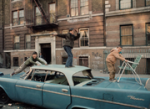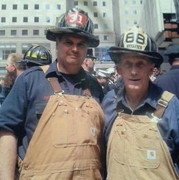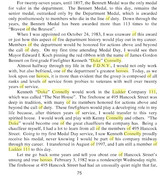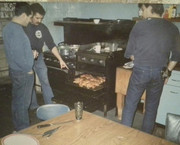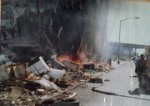ADV's; ABANDONED DERELICT VEHICLE FIRES
One thing for certain, almost every night you could be sure of responding to the signal 10-23; ‘Abandoned Derelict Vehicle’ fire or commonly referred to as an ADV. Abandoned ADV’s were the wildflowers of the South Bronx, almost every street had one or two parked at the curb in front of vacant apartment buildings and stripped to a skeleton shell of itself. There were vacant lots littered with them, a ghetto jungle gym.
“ENGINE ONLY; ADV, 88 GOES”...An ADV or vehicle fire was considered a “single unit response”. When I was first assigned to E 88 our typical operation was simple, the ECC would pull the rig as close to the ADV without the apparatus becoming an exposure and the first fireman to the rear of the rig would grab the booster hose from the back step and stretch the 20 feet or so to the “dumpster on wheels”. Our 1980 American LaFrance apparatus had a 1 inch booster line on the rear tailboard that had to be “hand cranked” after the operation, so we appreciated the ECC getting the apparatus close to the operation
Many vacant lots were loaded with stripped down vehicles. On occasion we’d come across a stripped down abandoned van blazing away, they were particularly hazardous. Free burning vans were of concern, disposed of by junkyards, sometimes these trojan horses were bulging with gas tanks, unknown liquid waste and drive shafts in the rear from other vehicles. We approached any van fire from an angle and distance employing the reach of a straight stream from the booster.
FDNY Procedure for any vehicle fire, including an ADV parked on the street was to position the hoseline between the vehicle fire and any exposure. The line was stretched, positioned and operated between the car fire and structure, it did not matter if the structure was vacant or not. ADV jobs were basically nuisance fires, hardly did we ‘gear up’, our usual attire was helmet and maybe a pair of gloves, donning an SCBA was not even a thought or considered. If you did not have the nozzle you grabbed a hook.
The company officer usually stayed in the front seat and let the men take care of the simple task, confident that the troops had the situation under control. Another reason was that an ADV was a simple job, the “War Years” boss, with hundreds of war year fires under his belt monitored the department radio just in case a more serious alarm came over the radio; the officer would have us ‘take up’ and respond.
ADV fires were prevalent in areas where the surrounding buildings were vacant or in an industrial area with light traffic. The vehicles, usually stolen and plates removed were torched, their value immediately squelched and ultimately “abandoned”. As soon as we extinguished the vehicle fire, local resident ‘mechanics’, adept at the art of disassembling a motor vehicle would close in like scavengers. Before we even left the scene, these mechanics proceeded to strip every inch of an undamaged part for resale to the local garage. The ideal business model,
“supply and demand” was well practiced with an endless supply of vehicles. Car tires, batteries, antennas, transmissions, hoods, frenders, bumpers, lights, shock absorbers, muffler system, carbs and engine blocks would all be disassembled in the wee hours. The vehicle would be picked clean.
FDNY MODIFIES RESPONSE
In 1984 a Queens firefighter from E 297 was struck and killed while operating at a van fire on the Whitestone Expressway when a drunk driver rear-ended the engine where the firefighter was standing. Shortly after that, the FDNY modified its response policy for vehicle fires, no longer a single unit response a Ladder Company was now added. The Ladder Company apparatus would be the blocking force to oncoming traffic while the crews operated in a safe perimeter.
************
One warm Summer Evening a television crew had permission to film the daily activity of L 38 responding to various alarms. I was detailed to drive the three person film crew in a ‘chase car’ behind the apparatus. That night we responded to the usual water leak, a few false alarms and a small vacant job. Around midnight we received a Phone Alarm for a ‘Vehicle Fire’ at 182 Street and LaFontaine Avenue. Both rigs make the right out of quarters then another right on 182 street to La Fontaine Ave straight ahead we can see the car blazing already. The car is parked by itself in front of the high bricked cobblestone wall of St. Barnabas Hospital, naturally in a no parking zone. The vehicle is a new model chevy and as to be expected there are no license plates. The passenger compartment of the vehicle is ripping.
Tonight's ECC pulls the engine tight to the curb, just in front of the burning vehicle as the television camera crew jumps from the Suburban, they are excited seeing and filming the flames. A fireman from E 88 advances the booster and within seconds the flames turn to steam.
I enlighten the camera crew and point to the gathering of “concerned” townspeople mingling across the street from the fire. I explained that the residents have laid down their ‘tools’ on the sidewalk under a blanket to conceal them just in case a police car happens by. In a few minutes they will pounce on the ADV for spare parts as soon as we depart. I mentioned to the film crew that in the morning before they finish their filming and depart I’d take them by this vehicle and they will not recognize it. They look at me quizzically. I explain that the townspeople will proceed to strip every nut and bolt of this vehicle and most likely it will be unrecognizable in the morning...It was.
Thanks for reading, hope you liked! KMG-365
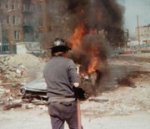
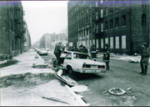
(Photo by D. Poole)
